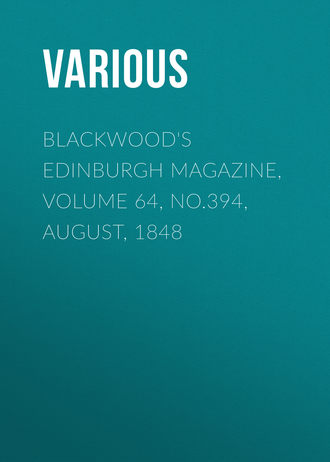 полная версия
полная версияBlackwood's Edinburgh Magazine, Volume 64, No.394, August, 1848
The last sketch in the Parisian Sketch-book, as it is now filled up – now in the middle of the month of July (for others may be painting even as these lines are traced) – is the dark monster hearse containing the bodies of those who have fallen in the cause of order – the black-behung altar in that Place, which has lost its name of Concord and Peace, to take the more suitable one of "Revolution" – the catafalk – the burning candelabras – the black-caparisoned horses that drag the funeral-car – the black draperied columns of the Madeleine – the authorities in mourning attire – the long procession – the sprinkled clouds of burning incense from the waved censers – and the widow's tears.
Such a picture of mocking pomp in desolate sorrow closes well the long suite of sketches with which the Parisian Sketch-book has been filled during the first phase of the French revolution. The curtain has fallen at the end of the first act, upon a tableau befitting the dark scenes which have been so fearfully enacted in it. The curtain will rise again – again will bloody scenes, probably, be enacted upon that troubled stage of history, – again will harrowing sketches, probably, be drawn in the Parisian Sketch-book. Those which we have now recorded have been selected from among thousands, because they form a suite, as natural in their course, as fatally inevitable, as any suite of pictures in which the satirising artist painted the natural course of a whole life. From the fallacious promises, and the foolish or culpable designs, that occasioned the establishment of those nurseries of discontent, disorder, and conspiracy, the ateliers nationaux, – the steps through the club-room, the rendezvous of the conspirators, the furious journalist's office, to the sedition, the insurrection, the carnage, the civil war, the murder, the terror, and the mourning catafalk, have followed as they could not but follow. It is only the first series, however, that is closed here. There can be little doubt but that similar consequences will again follow, as similar causes still exist; and that the red banner of the so-called "social and democratic republic" will again wave, – and perhaps before long, – a prominent object in the scenes of the Parisian Sketch-book.
1
A substance obtained from a gland in the scrotum of the beaver, and used to attract that animal to the trap.
2
The Hudson's Bay Company is so called by the American trappers.
3
A small lake near the head waters of the Yellow Stone, near which are some curious thermal springs of ink-black water.
4
The Aztecs are supposed to have built this city during their migration to the south; there is little doubt, however, but that the region extending from the Gila to the Great Salt Lake, and embracing the province of New Mexico, was the locality from which they emigrated.
5
Creoles of St Louis, and French Canadians.
6
"On the prairie," is the Indian term for a free gift.
7
Ancient and Modern Art, historical and critical. By George Cleghorn, Esq. 2 vols. Blackwoods. 1848.
8
Five Years in Kaffirland, with Sketches of the Late War in that Country. Written on the Spot. By Harriet Ward. Two vols. London, 1848.
The Cape and its Colonists, with Hints to Settlers, in 1848. By George Nicholson, Jun., Esq., a late Resident. London, 1848.
Three Years' Cruise in the Mozambique Channel, for the Suppression of the Slave Trade. By Lieut. Barnard, R.N. London, 1848.
9
Five Years in Kaffirland, vol. ii. p. 167-8.
10
Five Years in Kaffirland, vol. i. pp. 35-6.
11
Fingos, Kaffirs, and Hottentots, make use of a band or handkerchief, drawn tightly round the body, to deaden the pain of hunger; as the gnawing agony of famine increases, the ligature is tightened accordingly. —Five Years in Kaffirland, vol. i., p. 102.
12
Five Years in Kaffirland, vol. i. p. 304.
13
Ib., vol. ii. p. 191-2.
14
The Cape and its Colonists, p. 114.
15
Eastern Life, Past and Present. By Harriet Martineau.
16
The following singular story of circumstantial evidence is compressed from a collection of criminal trials, published at Amsterdam under the title "Oorkonden uit de Gedenkschriften van het Strafregt, en uit die der menschlyke Mishappen; te Amsterdam. By J. C. Van Kersleren, 1820." Notwithstanding the somewhat romantic complexion of the incidents, it has been included as genuine in the recent German collection, Der Neue Pitaval. 7 Band.
17
A mineral spring in the parish of Vinding, dedicated to St Matthew by the monks of a neighbouring convent, which existed there previously to the Reformation.











